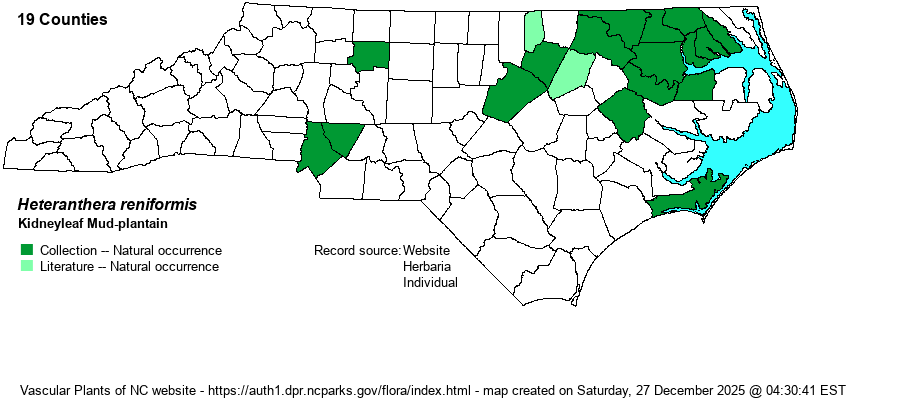| Author | Ruíz & Pavónis | |
| Distribution | With the separation of H. multiflora (in 2020 now all moved to H. pauciflora) from H. reniformis, all specimens of the latter must be identified anew. Recent review of specimens in SERNEC show its range as being limited mainly to the northern Coastal Plain, south to Carteret County, and westward sparingly in the Piedmont to Forsyth and Mecklenburg counties.
This is a broadly Eastern species, ranging from CT, NY, and IL south to northern FL and TX. There are two clusters of records on the BONAP map, one being from southeastern NY in the Coastal Plain south to northeastern NC; and locally in the lower Mississippi River drainage. | |
| Abundance | Probably rare to uncommon in the northern Coastal Plain, and rare but increasing in the adjacent northeastern Piedmont, but as specimens may need to be re-examined, the abundance status is not well known. Status farther south or west is not clear, and thus the specimens from Carteret and Forsyth need to be re-examined, especially in light of Davidson County specimens being re-assigned by B. Sorrie from this species to H. multiflora. The NCNHP rightly considers this as a Watch List species. | |
| Habitat | This species grows mainly in mud or very shallow water, in many situations. These spots can be on mudflats around lakes and ponds, on mudflats of tidal freshwater marshes, in swamp openings, in ditches, and in wet spots in trails or other clearings. Some of these muddy patches can be as small as one square-foot. | |
| Phenology | Blooms from June into October. Fruits soon after blooming. | |
| Identification | This species and H. pauciflora are quite similar and can be confused. This species has mostly kidney-shaped leaves that are somewhat wider than long, as opposed to more rounded in H. pauciflora. These thick and shiny leaves can be about 1-1.5 inches across. The short and often leaning or trailing flowering stem, often only a few inches long, contains mostly 2-8 flowers instead of 7-16 flowers in the other species. The flowers in H. reniformis are white to very pale blue, usually not as bright blue as some flowers in the other species. The anthers and filaments of this species contain white hairs; those in H. pauciflora have dark purple hairs. There is also a difference in the internode below the spathe, which is longer in this species (more than 0.4-inch) than in H. pauciflora. In general, this is a slightly smaller species, with white or whitish flowers, and more kidney-shaped leaves than found on H. pauciflora. You stand a decent chance to find one or both species if you work often in muddy patches in the Albemarle Sound region or other areas in the northeastern Coastal Plain. | |
| Taxonomic Comments | This has always been a good species, but note that H. pauciflora was not recognized as a species when RAB (1968) was published, and thus many if not most references in the 20th Century did not have H. pauciflora pulled out of H. reniformis.
| |
| Other Common Name(s) | Floating-leaf Mud-plantain | |
| State Rank | S2? [S3?] | |
| Global Rank | G5 | |
| State Status | W7 | |
| US Status | | |
| USACE-agcp | OBL link |
| USACE-emp | OBL link |

